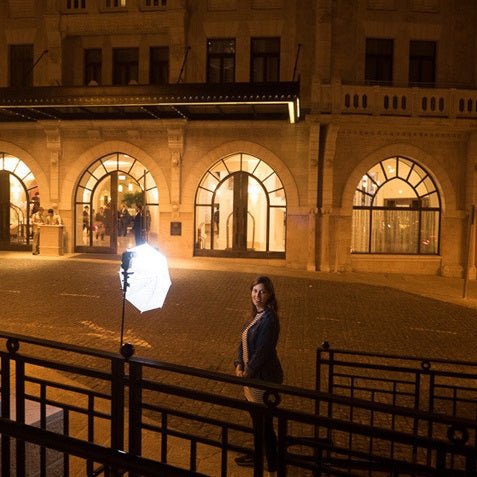Photographing a portrait is like baking an attractive cake, we need to mix all the necessary ingredients together, then shape and add personal flavor. Once the cake is in the oven, there’s no turning back, and the rest is a matter of fate, with the same mix of unease and anticipation that usually accompanies the moment we click the shutter.

Generally speaking, whether it is outdoor shooting or studio shooting, a portrait photography is roughly composed of characters, background and main light source. Through the organic combination of the three, the faces and souls of the characters can break out of the constraints of the picture and be transmitted to the viewer. In this process, the figure, background and light are the core ingredients needed to bake the cake, and the composition becomes the mold. Let’s find out how to bake a delicious portrait cake.
The city, especially after sunset, is never short of elements that inspire portrait photography. Every time the lights come on, we can take our favorite models through the streets of the city, looking for the composition, background and light we need to create. The key to success often depends on whether you have an eye for beauty, try to look for elements in the city through a portrait lens, and try to make use of the light created by existing sources in the environment. Of course, if the real conditions are not good, we can also use the off-board flash and white soft light umbrella to finish our shooting.
A bright shop in a dark corner
The portrait below was composed in the hope that it would emphasize dynamic contrast. This contrast of light and dark would draw the viewer’s eye firmly to the face and eyes in the bright part of the picture, thus creating an emotional connection between the subject and the viewer. The light source of the image is mainly from two parts: the soft cold light on the left side of the image, and the red circular light spot in the background of the image out of focus. This spot, together with the lips and eyes of the figure, forms a hidden triangular composition.

As you can see below, we did not use any soft light box when shooting this portrait, instead we used a light from a drugstore that was actually somewhat cluttered. The fluorescent lights in the drugstore provide a smooth and gentle light source, while the red spots in the background are from the traffic lights.

Hotel mystery
In the second photo, we chose to shoot the scene outside a classical-style hotel and added some figures into the picture. Here, the background plays a part in the story and helps the picture present a mysterious atmosphere. The main light source in this work is an off-camera flash placed at 90° on the model and shot through a gap in a metal railing. This approach helps to bring out the depth of the scene, while also blurring the streets, people and buildings in the background.

The lighting is shown in the following figure. The flash was placed four feet in front right of the model, and the flash output was manually set to 1/32 to match the light in the background.

Layer store
Layers are a term often used in post-editing images, but in the real world “layers” can be pretty ubiquitous, especially if you’re in a city. Shops at corners often have floor-to-ceiling glass Windows on both sides, which gives us the opportunity to use complex compositions, allowing the viewer’s eyes to explore the frame with multiple “layers” compared to simpler compositions. However, when using this type of composition, it is important to ensure that the viewer’s eye ultimately rests on the subject and focuses on the subject, so that it can be considered a portrait photograph. Through two glass Windows at different angles, the picture is divided into three main sections, and the figure is located in the right third of the picture.

Similarly, the main source of light in this photo is the off-camera flash, as you can see in the image below, which was taken through the left window of the store.

Shooting equipment
All in all, any camera with a good portrait lens and manual exposure controls will be able to take these pictures, and it’s up to the head behind the lens to make the final decision. For full-frame frames, a classic portrait lens is usually between 85mm and 105mm, while a secondary lens needs to be selected for the equivalent focal length. The advantage of using these lenses is not only to minimize distortion, but also to create a more ideal shooting distance. In addition, portrait prime lenses are often designed with a large aperture, while apertures greater than f/2 allow more light to enter the sensor, ideal for urban night light conditions and shallow depth of field.

0 comments